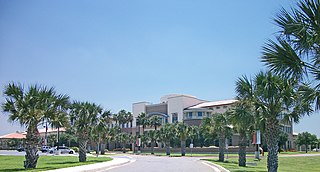
Harlingen is a city in Cameron County in the central region of the Rio Grande Valley of the southern part of the U.S. state of Texas, about 30 miles (48 km) from the coast of the Gulf of Mexico. The city covers more than 40 square miles (104 km2) and is the second-largest city in Cameron County, as well as the fourth-largest in the Rio Grande Valley. As of the 2020 census, the city had a population of 71,892.

Interstate 69 (I-69) is an Interstate Highway in the United States currently consisting of eight unconnected segments. The longest segment runs from Evansville, Indiana, northeast to the Canadian border in Port Huron, Michigan, and includes the original continuous segment from Indianapolis, Indiana, to Port Huron of 355.8 miles (572.6 km). The remaining separated segments are variously completed and posted or not posted sections of an extension southwest to the Mexican border in Texas. Of this extension—nicknamed the NAFTA Superhighway because it would help trade with Canada and Mexico spurred by the North American Free Trade Agreement (NAFTA)—seven pieces in Laredo, Texas; Pharr, Texas; Brownsville, Texas; Corpus Christi, Texas; Houston, Texas; northwestern Mississippi; and Memphis, Tennessee, have been built or upgraded and signposted as I-69. Indiana completed the fifth segment that extends I-69 through that state in August 2024.

U.S. Route 83 (US 83) is a major north–south United States Numbered Highway that extends 1,885 miles (3,034 km) in the central United States. Only four other north–south routes are longer: US 1, US 41, US 59, and US 87, while US 83 follows a straighter north-south path than all of these. Nearly half of its mileage is in the state of Texas. The highway's northern terminus is north of Westhope, North Dakota, at the Canadian border, where it continues as Manitoba Highway 83 (PTH 83). The southern terminus is at the Veterans International Bridge in Brownsville, Texas. Together, US 83 and PTH 83 form a continuously numbered north-south highway with a combined distance of 3,450 kilometres (2,140 mi).
The Trans-Texas Corridor (TTC) was a proposal for a transportation network in the U.S. State of Texas that was conceived to be composed of a new kind of transportation modality known as supercorridors. The TTC was initially proposed in 2001 and after considerable controversy was discontinued by 2010 in the planning and early construction stages.
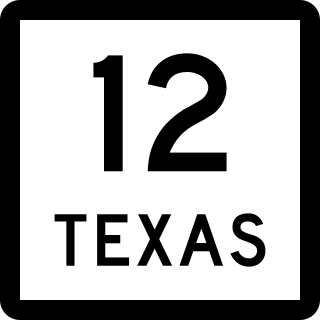
State Highway 12 (SH 12) is a west–east state highway in the U.S. state of Texas that runs from Interstate 10 (I-10) in Vidor to the Louisiana state line at Deweyville. The route was designated on August 27, 1959, as a renumbering of SH 235 to match the numbering of Louisiana Highway 12 (LA 12), with which it connects.

Texas state highways are a network of highways owned and maintained by the U.S. state of Texas. The Texas Department of Transportation (TxDOT) is the state agency responsible for the day-to-day operations and maintenance of the system. Texas has the largest state highway system, followed closely by North Carolina's state highway system. In addition to the nationally numbered Interstate Highways and U.S. Highways, the highway system consists of a main network of state highways, loops, spurs, and beltways that provide local access to the other highways. The system also includes a large network of farm to market roads that connect rural areas of the state with urban areas and the rest of the state highway system. The state also owns and maintains some park and recreational roads located near and within state and national parks, as well as recreational areas. All state highways, regardless of classification, are paved roads. The Old San Antonio Road, also known as the El Camino Real, is the oldest highway in the United States, first being blazed in 1691. The length of the highways varies from US 83's 893.4 miles (1,437.8 km) inside the state borders to Spur 200 at just 0.05 miles long.
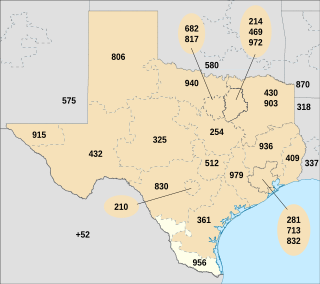
Area code 956 is a telephone area code in the North American Numbering Plan for the Lower and Middle Rio Grande Valley regions in the U.S. state of Texas. The numbering plan area includes the communities of Brownsville, McAllen, Laredo and South Padre Island. The area code was created May 25, 1997, in a split from area code 210.

State Highway 48 runs from Brownsville to Port Isabel in Deep South Texas.
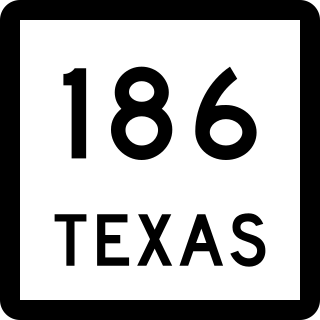
State Highway 186 is a state highway in the Rio Grande Valley in Hidalgo and Willacy counties in Texas, United States, that connects U.S. Route 281 (US 281), future Interstate 69C, and Farm to Market Road 1017 (FM 1017) in Linn with the Gulf of Mexico at Port Mansfield.

Loop 20, also known as the Bob Bullock Loop and Cuatro Vientos Road, is a highway loop that runs to the north and east of the city of Laredo, Texas. Loop 20 extends from the World Trade International Bridge at its northern point to Mangana-Hein Road at its southern point. The current route varies in construction from a 2-lane road to a freeway with frontage roads.

U.S. Highway 83 (US 83), dedicated as the Texas Vietnam Veterans Memorial Highway, is a U.S. Highway in the U.S. state of Texas that begins at US 77 in Brownsville and follows the Rio Grande to Laredo, then heads north through Abilene to the Oklahoma state line north of Perryton, the seat of Ochiltree County.

U.S. Route 281 (US 281) is a United States Numbered Highway that runs from the Mexican border in the Rio Grande Valley to the Canadian border near Dunseith, North Dakota. In the state of Texas, the highway is a major south–north corridor, connecting Brownsville to the Oklahoma state line at the Red River in Burkburnett. Several segments of U.S. 281 are concurrent with Interstate routes, including I-69C in the Rio Grande Valley, I-37 in San Antonio, and I-44 north of Wichita Falls.

U.S. Route 77 (US 77) is a major highway that is part of the United States Numbered Highway System that runs from the Veterans International Bridge in Brownsville to Sioux City, Iowa. In Texas, the road runs south-north for 471.3 miles (758.5 km) from the International border with Mexico to the Oklahoma state line north of Gainesville. The highway is being upgraded to a freeway near Corpus Christi to connect to the freeway part of the highway in Raymondville as part of future I-69. A freeway in Robstown is already signed as part of I-69. From Waco to the Oklahoma state line, US 77 overlaps or runs parallel to I-35/I-35E.
The Ports to Plains Corridor, also known as National Highway System High Priority Corridor 38, is a highway corridor between the United States Mexico border at Laredo, Texas and Denver, Colorado. It is the southern third of the Ports-to-Plains Alliance. The reason for proposed improvements to this corridor is to expedite the transportation of goods and services from Mexico in the United States and vice versa. The proposed improvements gained momentum with the signing of the FY22 Omnibus Appropriations bill, which designated a section of the highway part of the interstate system. The Ports-To-Plains Corridor starts in South Texas and traverses through Texas, New Mexico, Oklahoma, and ends in Denver, Colorado.

Interstate 69 (I-69) is an Interstate Highway that is in the process of being built in the U.S. state of Texas. It is part of a longer I-69 extension known as the NAFTA superhighway, that, when completed, will connect Canada to Mexico. In Texas, it will connect Tenaha and the Louisiana segment of the route through the eastern part of the state and along the Texas Gulf Coast to Victoria, where it will split into three branches: I-69E to Brownsville, I-69C to Pharr, and I-69W to Laredo. The first segment of I-69 in Texas was opened in 2011 near Corpus Christi. The American Association of State Highway and Transportation Officials (AASHTO) approved an additional 58 miles (93 km) of U.S. Highway 77 (US 77) from Brownsville to the Willacy–Kenedy county line for designation as I-69, which was to be signed as I-69E upon concurrence from the Federal Highway Administration (FHWA). FHWA approval for this segment was announced on May 29, 2013. By March 2015, a 74.9-mile (120.5 km) section of US 59 had been completed and designated as I-69 through Greater Houston. As of 2024, short segments near the southern terminuses of the three branch routes have also all been completed. These branches are planned to be connected to the rest of Interstate 69.
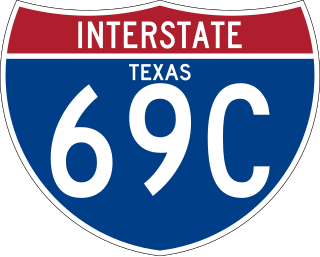
Interstate 69C (I-69C) is a north–south Interstate Highway running through South Texas. Once complete, the freeway will begin at I-2/U.S. Highway 83 (US 83) in Pharr and head northward before terminating at I-69W/US 59 in George West near I-37. For its entire length, I-69C is concurrent with US 281. As of 2023, only an 18-mile (29 km) segment has been completed at the route's southern terminus in Pharr.

Interstate 69E (I-69E) is a north–south Interstate Highway running through South Texas. Once complete, the freeway will begin in Brownsville and head northward before terminating near Victoria as both I-69W and I-69E merge into I-69 toward Houston. For its entire length, I-69E runs concurrently with U.S. Highway 77 (US 77). The route currently exists in two segments: a 56.894-mile (91.562 km) segment from its southern terminus in Brownsville to the Willacy–Kenedy county line and a shorter 24.106-mile (38.795 km) segment south of Corpus Christi. The route has one auxiliary Interstate route, I-169 in Brownsville.

Interstate 69W (I-69W) is a relatively short north–south Interstate Highway running through South Texas in the United States. The freeway begins northeast of the middle of the World Trade International Bridge in Laredo and ends at I-35. In the future, I-69W will head northeast for 180 miles (290 km) before terminating near Victoria as both I-69E and I-69W merge to form I-69. For its entire length, I-69W runs concurrently with U.S. Highway 59 (US 59).

Business US Route 83-S is a business loop of US 83 in the Lower Rio Grande Valley region of Texas. The highway serves as the main street for many communities in the area, such as McAllen, Mission, San Juan, Alamo, and more. This is the longest business loop in Texas, traveling almost 47 miles and is the third longest bannered US highway in the state; only US 90 Alternate and US 77 Alternate are longer.
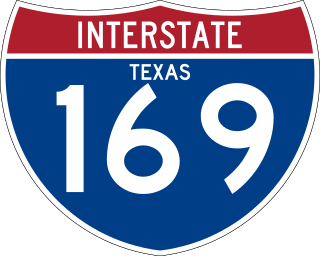
Interstate 169 (I-169) is an auxiliary route of I-69E in Texas that currently runs from I-69E in Brownsville southeast concurrently with State Highway 550 (SH 550), a toll road under construction that connects to the Port of Brownsville for 1.5 miles (2.4 km). When SH 550 is complete, it will be a limited-access toll route around the northern and eastern edges of Brownsville and signed as I-169, partly replacing and expanding Farm to Market Road 511 (FM 511). Its purpose is to provide a new entry point for truck traffic to the Port of Brownsville and forming a loop that allows traffic to bypass the northern sections of the urbanized extent of the Brownsville city limits. This may serve as a relief route for future traffic congestion and as a future business corridor.


















